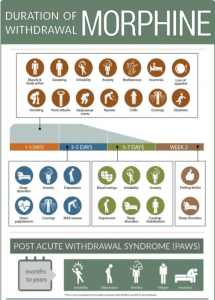Morphine Withdrawal

There are many who face morphine addiction and symptoms from morphine withdrawal due to trying to quit the addiction. There are certain ways to go about quitting a morphine addiction to protect yourself from the dangerous side effects associated with morphine withdrawal. Morphine is used as a pain reliever for those with moderate to severe pain typically used in cases of chronic pain. However, because patients have to take the medication for a prolonged period of time, it is a slippery slope and can easily become an addictive substance if not taken correctly. Keep reading to find out more about morphine withdrawal and how to avoid the dangerous side effects.
What is morphine addiction?
Tolerance occurs after a time of taking the medication for an extended period, which means a higher dosage of morphine is required in order to achieve the same levels of pain relief. This is why morphine is one of the most addictive medications. It works as a reward system to the brain, which causes the individual to crave the morphine. Those who suffer from morphine addiction may alter their lives or change routines in order to get their regular morphine fix. Many who suffer from morphine addiction also may inhibit their ability to function normally without taking the morphine. Morphine withdrawal symptoms are also a large clue indicating whether or not a person is addicted to morphine.
Morphine withdrawal symptoms?
When a person is addicted to morphine, they will experience moderate to severe morphine withdrawal symptoms if they attempt to stop using the medication abruptly or if they have used it for a very long period of time. These morphine withdrawal symptoms include:
- Nausea
- Tearing
- Yawning
- Chills
- Prolonged sweating
- Emotional trauma
- Stroke
- Heart attack
- Death
Because the morphine withdrawal symptoms range from moderate to severe it is important to never try to self-detox from morphine addiction.
How to treat morphine addiction:
There are a few ways to go about treating morphine addiction without having to deal with the dangerous morphine withdrawal side effects. Detoxification should be done under a doctor’s supervision or direction in order to avoid the morphine withdrawal symptoms. Many can handle some of the morphine withdrawal symptoms like nausea, fatigue and sweating on their own as long as they are able to check in regularly with their doctor to make sure the symptoms do not get too severe. However, for those with a more severe morphine addiction, it is recommended to try checking into a rehabilitation or residential treatment center to get direct and constant supervision while dealing with the morphine withdrawal symptoms. That way, in case of severe withdrawal, the patient can be treated quickly to prevent cases of stroke, heart attack and even death. These treatment centers also provide counseling and support during the time of addiction treatment, which can help prevent relapsing and continued addiction.
Sources: narconon.ca/morphine.htm, softlandingrecovery.com, addictionblog.org






